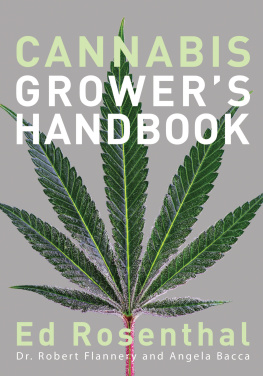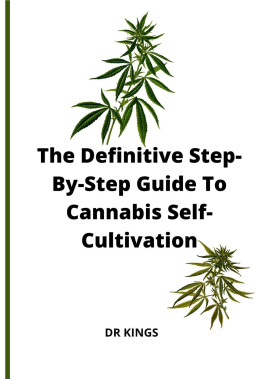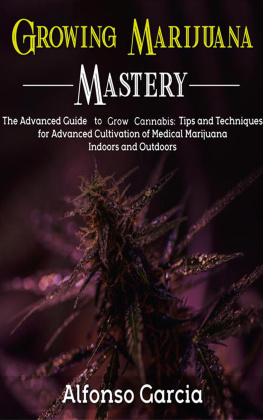Cultivating
Exceptional Cannabis




Cultivating Exceptional Cannabis
Copyright 2003 DJ Short
ISBN: 978-1-936807-12-3
1st edition, 1st printing
Project Staff: S. Newhart & Jaloola
Cover Photo: Heirloom Blueberry by Andre Grossmann
Cover Design: D/Core
Interior Design: Small World Productions, San Francisco
Chapters 2-13, 16, 17 and 18 are revised from articles that previously appeared in Cannabis Culture magazine.
The material offered in this book is presented as information that should be available to the public. The Publisher does not advocate breaking the law. However, we urge readers to support the secure passage of fair marijuana legislation.
All rights reserved. No part of this book may be used or reproduced in any manner whatsoever without written permission of the Publisher, except in the case of brief quotations embodied in critical articles or reviews.
To the plant, and all who serve her.
And to Canada, who will hopefully continue to do the right thing despite the Elephant with whom she sleeps.
O Canada!
Our home and native land!
True patriot love in all thy sons command.
With glowing hearts we see thee rise,
The True North strong and free!
From far and wide,
O Canada, we stand on guard for thee.
God(dess) keep our land glorious and free!
O Canada, we stand on guard for thee.
O Canada, we stand on guard for thee.
Thank you.
Contents
Its about time. A time to sprout and plant. A time to water and feed. A time to mature and grow. A time to develop and age. And finally, a time to cut, cure and, last but not least, consume the fruits of the labor. There once was a time, not-too-ancient, when it was all done in the great outdoors, under the full open sky.
But, as fate would have it, some creatures have chosen to appoint themselves as predators. They have chosen to prey upon the good folk who produce and use the blissful fruit. Some of the more sadistic control freaks of the world have taken it upon themselves to fabricate rules and laws that, supposedly, demonize and criminalize the production, transport, sale, possession and/or use of the amazingly benign and benevolent substance we know as cannabis. These latter day witch-hunters like to believe that they are succeeding. But we know better.
Welcome to the humble indoors. I am trying to accept the fact that I have been a closet horticulturist for thirty years now. I have the white hairs to prove it! (Pun intended.) Perhaps the greatest lesson the plant has taught me in all of my years of experience with her is that of patience. This plant has taught me the virtue and the potential value of waiting. Plants also have the ability to show us what it means to make the best out of a given situation. This book explains ways to cultivate patience and optimal conditions to produce a garden of exceptional quality.
Before Indoors
In the early 1970s we did not know much at all about growing good herb. We had grand quantities of seed from the commercial Mexican and Colombian herb we were consuming and we knew the plants grew from seeds. But we couldnt get the damned things to sprout, no matter how we tried. Years later we found out that the seeds in the large commercial shipments were sterilizedsome by pressure, heat or it is rumored by irradiation.
Two phenomena sparked what would become my lifelong ambition. The first came in 1973, when I received a little seed sprouting chambera two-inch round, clear plastic bubble that came as a prize in a box of breakfast cereal. It had one flat side that opened with a little sponge that sat in the bottom. The second phenomenon was that I had acquired a decent quantity of good, semi-commercial, seeded Hawaiian. I put a whole fingertip-sized seeded bud into the moistened chamber. A few days later the seeds sprouted and roots shot through the budsand away we went! These early plants sat under a twelve-inch fluorescent desk lamp and grew to be a foot or two tall.
In 1974 another important event occurred: the founding of High Times magazine. Tom Forcades vision had accurately pegged an era and served a movement. I was a teenager when I bought my first copy, the second issue (the first issue was sold out by the time I discovered them). High Times lent a great amount of credibility to what many of us knew to be true; that certain personal freedoms and liberties are natural rights, yearning to be exercised and expressed. Then in the mid-1970s, Mel Frank, Ed Rosenthal and Murphy Stevens finally taught us how to grow the good buds through their timely how-to grow books.
After this point, some American growers became proficient at growing the herb and understanding its finer qualities. Some of these growers moved to regions of the world famed for high quality cannabis. (I like to refer to these specific regions as sweet spots.) Many teamed up with the locals; others designed their own production schemes. Their collective goal was the sameto help produce high quality, semi-commercial quantities of indigenous and designer cannabis. Many of these entrepreneurs were successful in their quests, both in quantity and quality.
The Herbal Expansion
From the mid-1970s to the early 1980s, some of the finest herb of all time was produced in these sweet spots. They included, but were not exclusive to, highland Oaxaca and much of Southern Mexico, Colombia, Thailand, Nepal, many parts of Africa, Afghanistan, Hawaii, Jamaica and the Northern California/Southern Oregon coastal mountain regions. These were the areas from which came the acclimated land race varieties that were the P1 generations of much of the seed genetics available today.
What made each of these varieties of herb so unique and desirable is the head or mental feeling the bud gives. A question often asked of the herb experience is: Does it have a good head? (Or a happy, goofy, stony, sleepy, paranoid, nervous head.) Each of the sweet spot regions had its own ganja with its own unique head and palate. This is not often attainable in the limited environments of our indoor grow worlds. But we are getting closer!
Please note that a good-head high is not entirely dependent upon set and setting. Up until the late 1970s my setting was Detroit, Michigan. And there are few set and settings more depressingly awful than Detroit in the winter. And yet my buds and I were able to get really incredibly highhigh enough to rise above the depression of the urban blight. And I attribute much of my anti-depression (and intact survival for that matter) to the high quality, good-head herb available to me then. Good-head herb also has a tendency to expand the consciousness of those who use it. My expanding consciousness soon began to learn of an Oz-like land to the west.
Next page






